
Texas Wildlife Research Program
Pittman-Robertson Grant Highlights
Each year, the TPWD Wildlife Research Grants program awards between $1 and $2 million in federal Pittman-Robertson Act funds for research on Texas’ native wild birds and mammals. This process starts with an annual review by Wildlife Division staff to identify our current, greatest research needs for managing these species. Based on that review process, we then post requests for proposals online for those research needs, and the Wildlife Division follows a competitive review process to award project proposals submitted by qualified Universities or non-governmental organizations. Below are the highlights of projects awarded over the last 7 annual funding cycles of the program (from fiscal year 2019 onward).
Fiscal Year 2022
Black Skimmer Conservation along the Texas Gulf Coast
Principal Investigators: David Newstead — Coastal Bend Bay and Estuaries Program
Christopher Serenari and Elena Rubino — Texas State University
TPWD Project Coordinator: Trey Barron
Status: In Progress
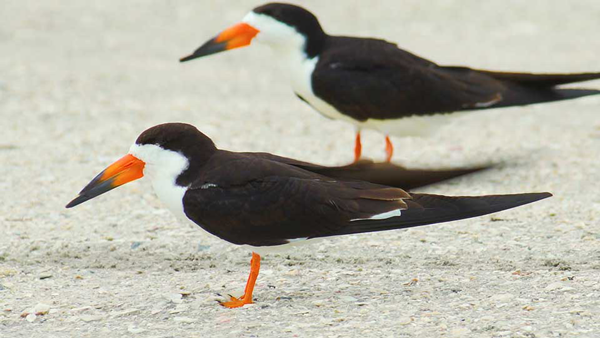
Black Skimmer birds can be found across the Texas coast.
Project Summary: The Black Skimmer is an iconic coastal seabird that can be found across the Texas coast. It nests on small islands and shell ridges in bays. The species has declined by as much as 70% in the past 40 years, and they face multiple threats that continue to jeopardize their persistence in the state’s waters. Low reproductive success is considered one potential driver of the decline, and this project aims to better understand the factors limiting their success. We are approaching this through multiple related lines of inquiry: GPS-tracking of birds to determine how far (and to what habitats) they are traveling while raising young; determining frequency of supertidal events that wash out nesting colonies; assessing frequency and causes of colony disturbance and their effect on colony success; evaluating prey resources that may be limiting; and assessing knowledge and perceptions of coastal nesting waterbirds among coastal user groups.
In the first year of the study, we found that skimmers mostly forage within about 10 km of their nesting colony while provisioning their young, with occasional visits to more distant sites. There were no major supertidal events in 2022, but disturbance of nesting colonies was variable across sites. Colonies were occasionally disturbed by fishermen, and some were frequented by Crested Caracaras which result in flush responses potentially causing decreased reproductive success. Collaborators with Texas State University have been conducting in-person and push-to-web surveys of recreationists. Preliminary results indicate respondents perceive anglers as the largest threat to waterbirds and that a strategy to enhance self-governance among recreationists in remote spaces is required to mitigate disturbances to these avian species.
A multi-scale assessment of habitat connectivity on chestnut-bellied scaled quail populations
Principal Investigators: Evan P. Tanner, Fidel Hernández, Ashley M. Unger, Humberto L. Perotto-Baldivieso, Leonard A. Brennan, David G. Hewitt and David B. Wester — Texas A&M University-Kingsville
Ryan Luna — Sul Ross State University
TPWD Project Coordinator: John McLaughlin
Status: In Progress
Project Summary: The chestnut-bellied scaled quail has experienced distribution-wide declines in recent decades and currently occupies a smaller portion of their historic range. Compared to statewide trends, the chestnut-bellied scaled quail is exhibiting some of the greatest declines in populations, which is primarily occurring in the Tamaulipan Biotic Province (about 4% per year according to the Breeding Bird Survey). Although the mechanistic causes of the scaled quail decline are unknown, habitat loss and fragmentation resulting from land-use changes are likely contributing factors.
To address these declines, researchers are using a multi-scale approach in which local and distribution-wide relationships are assessed. At two study sites, GPS transmitters are being utilized to assess fine-scale movement patterns, survival and nest success in relation to non-native grasses, oil-gas development and abiotic conditions (i.e., local factors). At the distribution-wide extent, researchers are quantitatively linking landscape structure and connectivity to population performance and occupancy of chestnut-bellied scaled quail (i.e., landscape factors) across a large temporal extent (i.e., multi-decadal). In tandem, researchers plan to determine if specific avian species are indicator species that can predict potential future declines in scaled quail populations (i.e., preemptive screening) to help target conservation efforts through regional avian community surveys.
As of May 2023, about 600 birds have been banded, about 120 birds have been equipped with GPS transmitters, and over 1,000 point count surveys have been conducted. Collectively, these data will be analyzed to help understand the factors that are driving populations in South Texas and what interventions may be needed to arrest population declines. Work is scheduled to continue through 2025.
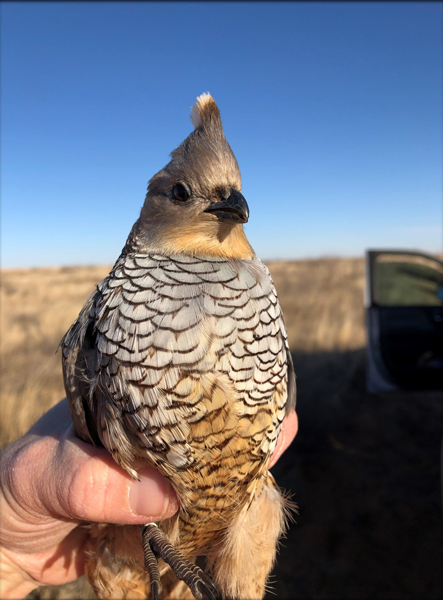
Chestnut-bellied scaled quail bird
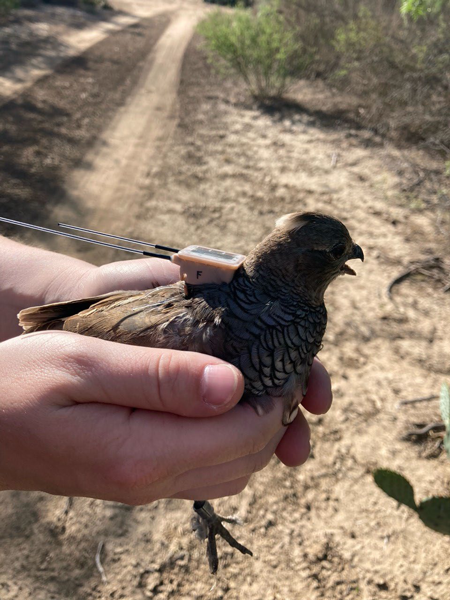
Chestnut-bellied scaled quail bird with a transmitter attached to it's back.
Statewide Black-tailed Prairie Dog Distribution Status Update
Principal Investigators: Rachel Fern — Texas Parks and Wildlife Department
TPWD Project Coordinator: Jonah Evans
Status: In Progress
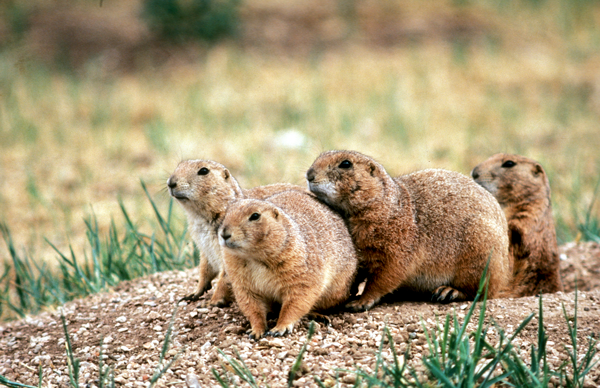
Black-tailed prairie dog family
Project Summary: The black-tailed prairie dog (Cynomys ludovicianus) (BTPD) historically ranged across 11 U.S. states, Canada and Mexico including most of the western third of Texas; however, the current range is estimated to be 1% of the species historical distribution; a contributing factor to the species being petitioned for federal listing as threatened in 1998. A variety of threats including plague, habitat loss, poisoning and recreational shooting have reduced numbers of black-tailed prairie dog from the vast numbers reported in Texas from the early 20th century and across the range of the species. BTPD are an important part of the grassland ecosystems of western Texas. Their burrows and surrounding low-cut vegetation provide habitat for a variety of species including mountain plovers (Charadrius montanus) and western burrowing owls (Athene cunicularia hypugaea). The purpose of this project is to inform management strategies for the conservation of BTPD by developing a tool to identify spatial extent of BTPD colonies statewide.
To achieve this, we use satellite-borne imagery to define the current extent of BTPD distribution across the state (task 1) and develop and employ an automated image processing algorithm, ground-truthed by aerial imagery, that allows repeated, automated identification of BTPD colonies in the future as new satellite imagery data become available (task 2).
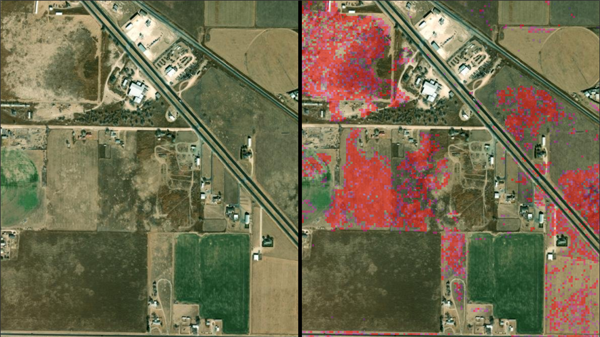
Black-tailed prairie dog town in Muleshoe
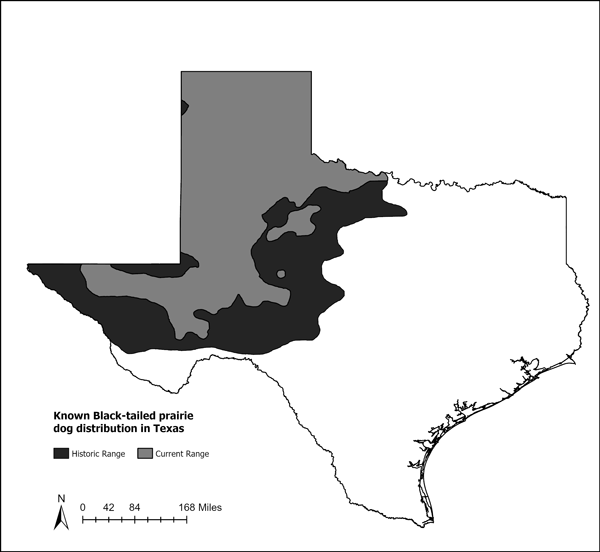
Black-tailed prairie dog distribution in Texas